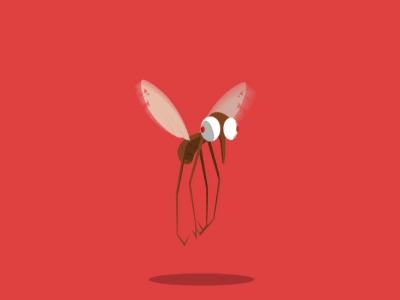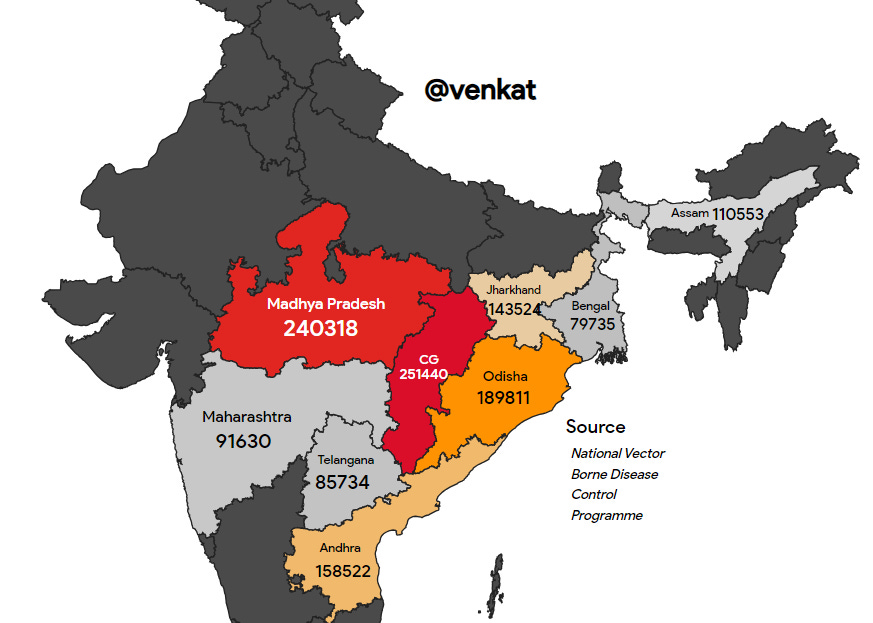Where do we stand on Malaria?
Lets see how we have tackled the deadly disease of malaria in past decade
👋 Hi, this is Venkat and here with a free, full issue of the The The Quantified India Newsletter. In every issue, I cover topics in a simpler terms in areas related to india with data etc.
If you are new here feel free to read the older article .
Malaria the deadly disease that kills half a million people every year is still relevant and killed more people than the recent Covid. Damn!
Yes, malaria killed more people than COVID-19 in 2020. According to the World Health Organization (WHO), there were an estimated 627,000 deaths from malaria in 2020, while there were an estimated 545,000 deaths from COVID-19.
The World Health Organization (WHO) estimates that 558,000 people died because of malaria in 2019; the Institute of Health Metrics and Evaluation (IHME) puts this estimate at 643,000.
Malaria is a more deadly disease than COVID-19. The case fatality rate for malaria is estimated to be around 2%. The case fatality rate for COVID-19 is much lower, at around 0.5%
So where does India Stand. You ask ?
Lets peek more about the malaria in Indian Perspective.
Malaria is a mosquito-borne disease that can cause fever, chills, and flu-like symptoms. It is a major public health problem in India, with an estimated 17 lakhs cases reported in 2022.
The two main types of malaria that are found in India are Plasmodium falciparum and Plasmodium vivax.
P. falciparum is the most serious type of malaria, and it can be fatal if not treated.
P. vivax is less serious, but it can still be a serious illness.
Malaria is transmitted by female Anopheles mosquitoes. These mosquitoes bite during the night, and they are most active at dusk and dawn.
The risk of malaria is highest in rural areas, especially in the forested areas of the country. However, malaria can also be found in urban areas, especially in areas with poor sanitation.
Malaria was first discovered in 3rd century BC. The word "malaria" comes from the Italian word "mala aria," which means "bad air." This is because people used to believe that malaria was caused by bad air.
The mosquito that transmits malaria, Anopheles, is named after the Greek goddess of night, Anophele.
Lets scratch some data to see how the pattern of malaria cases
Top 20 countries cases vs Deaths in 2020
Interesting fact, you can see, the top 20 countries for malaria cases and deaths are all located in sub-Saharan Africa with an exception as India (Asia)!
This is because the region has the perfect climate for the mosquitoes that transmit malaria. The mosquitoes that transmit malaria thrive in warm, humid climates. They also breed in standing water, which is common in many parts of sub-Saharan Africa + India and added poor maintenance.
While the fatal percent in India is quite lower as per the stat and hence its missing in the second graph!
As per the WHO report,
In 2022, India reported an estimated 17 lakhs cases of malaria.
Of these cases, 52,000 were fatal.
But now you may think where in India this cases are happening ryt ?
Wow you can see a clear pattern of all the connected states are impacted due to this. There may be several reason to this but most important ones to be concentrated on.
Geography: Both states are located in the central and eastern parts of India, which are areas with high transmission rates of malaria.
Poverty: Both states are also relatively poor, and poverty is a major risk factor for malaria. People living in poverty often have limited access to healthcare and preventive measures, such as insecticide-treated bed nets.
Poor sanitation: Poor sanitation is another major risk factor for malaria. Mosquitoes that transmit malaria breed in standing water, and poor sanitation can lead to an increase in the number of breeding sites for mosquitoes.
but India has came a long way.
Consider the population in 1980 and the number of deaths 1.6 lakhs is way more than current 52K deaths in 1.44 billion people.
Look at the last two decade we reached to 29000 deaths and peaking in 2022 to 52000
As you can see, the number of deaths from malaria in India has been declining in recent years. However, there was a slight increase in deaths in 2022. This is likely due to a number of factors, including the COVID-19 pandemic, which disrupted malaria control efforts.
The government of India is committed to eliminating malaria from the country. However, more needs to be done to achieve this goal. Continued investment in malaria control interventions, as well as efforts to address the underlying factors that contribute to the spread of malaria, are essential and working towards all the challenges
Challenges ?
There are a number of reasons why malaria is still prevalent in India, including:
Large population size. India has a population of over 1.4 billion people, which makes it the most populous country in the world. This makes it difficult to reach everyone with malaria prevention and treatment services.
Complex geography. India has a diverse geography, with a wide range of climates and terrain. This makes it difficult to control the mosquito vectors that spread malaria.
Drug and insecticide resistance. The malaria parasites and mosquitoes that transmit malaria are becoming increasingly resistant to drugs and insecticides. This makes it more difficult to treat and prevent malaria.
Poor infrastructure. In some parts of India, the infrastructure for providing malaria prevention and treatment services is not well-developed. This makes it difficult to reach people with these services.
Migration. People in India often migrate from rural to urban areas, and from one state to another. This can spread malaria to new areas, making it difficult to control the disease.
The Government role
The Government spends around 1500 crore each year on malaria eradication by providing bed nets to people in high-risk areas, and it also provides financial assistance to people who cannot afford to buy bed nets.
Each year people from municipalities on Indoor residual spraying a method of applying insecticide to the walls of homes to kill mosquitoes.
They also provide free drug on government run health centers.
The MEP 2030 Plans
The MEP was launched in 2017 with the goal of eliminating malaria from India by 2030.
The MEP is a multi-sectoral initiative that involves the participation of the government, the private sector, and civil society.
The MEP is working to implement a number of interventions to control malaria, including the distribution of insecticide-treated bed nets, the use of indoor residual spraying, and the provision of antimalarial drugs.
Focus on high-risk areas: The plan will focus on the states and districts with the highest incidence of malaria.
Use of innovative technologies: The plan will use innovative technologies, such as digital mapping and mobile health, to track the spread of malaria and deliver interventions more effectively.
Community participation: The plan will involve communities in all aspects of malaria control, from education and awareness to reporting cases.
The MEP 2030 is a bold and ambitious plan, but it is one that is achievable with the support of the public and the private sector.
I hope India would eradicate the Malaria and can shift the focus on improvements.









